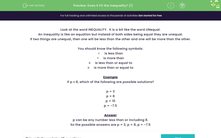Look at the word inequality. It is a bit like the word unequal.
An inequality is like an equation but instead of both sides being equal, they are unequal.
If two things are unequal, then one will be less than the other and one will be more than the other.
You should know the following symbols:
< means less than
> means more than
≤ means less than or equal to
≥ means more than or equal to
Example
If p + 3 ≤ 8, which of the following are possible solutions?
p = 3
p = 8
p = 10
p = -7.5
Working and answer
We need to find out the value of p:
p + 3 ≤ 8
Subtract 3 from both sides
p ≤ 5
So, p can be any number less than or including 5.
So the possible answers are p = 3, p = -7.5
Does that make sense?
Just as with 'normal' equations, we need to make sure that anything that we do to one side is also done to the other side - otherwise you'll get the wrong answer!!

Let's have a go.








